 W
WThe Alesis Andromeda A6 is a 16-voice, 16-channel multitimbral analog synthesizer by Alesis which was released in 2000 and discontinued in 2010. The Andromeda has analog oscillators and filters combined with modern digital control. It can be considered a hybrid of older and newer technologies, but its entire signal path is purely analog. The VCOs have a very practical pitch correction function, a feature missing on other old polysynths. The VCOs have FM and ring modulation and sub-oscillators. These features makes it possible to create a much wider sonic palette than usual on analog polysynths.
 W
WThe Arcadetar is a music performance controller, developed in 2012 by the Italian engineer and composer Andrea Lomuscio. It consists of a 25-note keyboard embedded in a guitar body, and a guitar neck with position and pressure sensors.
 W
WAn Arduinome is a MIDI controller device that mimics the Monome using the Arduino physical computing platform. The plans for the Arduinome are released under an open source, non-commercial use only license. The Arduinome platform is noted for providing a lower cost alternative to the Monome and allows greater hackability of the interface.
 W
WThe Casio SK-1 is a small sampling keyboard made by Casio in 1985. It has 32 small sized piano keys, four-note polyphony, with a sampling bit depth of 8 bit PCM and a sample rate of 9.38 kHz for 1.4 seconds, a built-in microphone and line level input for sampling, and an internal speaker. It also features a small number of four-note polyphonic preset analog and digital instrument voices, and a simple additive voice.
 W
WThe Croix Sonore is an early electronic musical instrument with continuous pitch, similar to the theremin. Like the theremin, the pitch of the tone is dependent on the nearness of the player's arm to an antenna; unlike the theremin, the antenna was in the shape of a cross, and the electronics were inside a brass ball to which the cross was affixed.
 W
WThe E-mu Audity was a digitally controlled, analog synthesizer made in 1978. It was inspired by Tangerine Dream's Peter Baumann, and eventually evolved into a state-of-the-art, 16-voice polyphonic analog synthesizer with an included digital keyboard and sequencer that was intended to compete with Sequential Circuits' Prophet 5. The project was funded with royalties from Sequential Circuits for their use of E-mu's digital scanning technology in their keyboards, and was to be sold for $69,200.
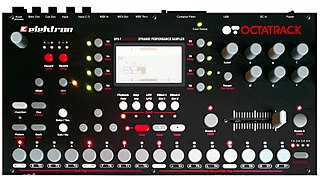 W
WThe Octatrack DPS-1 is a digital electronic music instrument made after the Machinedrum UW by Elektron Music Machines. An LCD surrounded by hand controls let the user interact with sampler, step sequencer, mixer, and effect features while stereo audio and MIDI signals are continuously output.
 W
WThe Eminent 310 Unique is a home electronic organ that was built and introduced in 1972 by the Dutch organ manufacturer Eminent, at the time based in Bodegraven, the Netherlands. It was the first organ to include a string section, making it the first commercial polyphonic string synthesizer on the market. It is prominently featured on Jean Michel Jarre's albums Oxygène (1977) and Équinoxe (1978).
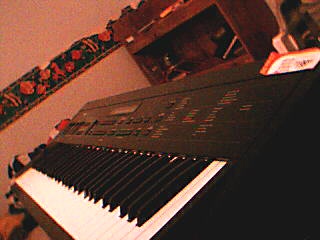 W
WThe Korg DS-8 is an expandable FM synthesizer released by KORG in 1986 which used the Yamaha FB-01 FM synthesis engine with 4 sine wave oscillators. 61 Keys in length with both initial and switchable aftertouch capabilities it stores up to 100 programs and 10 combinations in its internal memory. By using one of the optional non-volatile KORG RAM cards MCR-01, MCR-02, or MCR-03 this program memory can be expanded by extra programs and combinations: 100/10 for the MCR-01, 200/20 for the MCR-02, or 400/40 for the MCR-03. Programs can be backed up and received via standard MIDI dumps.
 W
WThe Korg Minilogue is a two VCO per-voice, four-voice, polyphonic analog synthesizer from Korg, designed by Korg engineer and synthesizer designer Tatsuya Takahashi. It was announced just prior to NAMM 2016, and is priced new at $499.99 in the United States, ¥55,000 in Japan and £449 in the United Kingdom and Europe. Its official release was preceded by leaks which caused media speculation.
 W
WThe Korg X3 is a music workstation produced by Korg in 1993. The X3 features 200 programs, 200 combinations, 32-voice polyphony, a 32,000 note, 16-track sequencer with 100 patterns and 10 songs and a double-sided, double-density 3.5-inch floppy disk drive for song and other data storage types. Korg also released the X2 (76-key) with 8 Mbyte ROM in 1994 along with a rackmount version dubbed the X3R, which also had a floppy disk drive.
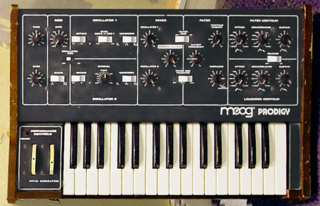 W
WThe Moog Prodigy was a monophonic analogue synthesizer produced by Moog Music from 1979 to 1984. Of the 11,000 produced, versions released after 1981 included a control voltage/gate input on the back that allowed the VCF to be triggered and controlled by an external source. These later versions began at serial number 4610. The official model number of the instrument is 336. 336A would indicate a domestic (US) model, while a 336BX would indicate an export unit.
 W
WThe Clavia Nord C1, Nord C2, Nord C2D are digital keyboards aimed at emulating various vintage organs. The Nord C1 was released in 2007, aimed mainly at the "gigging musician" as a digital replacement for the Hammond, Vox and Farfisa electric organs. In 2009 it was replaced by the Nord C2, which added emulation of a baroque pipe organ to widen its appeal to "churches, concert and congregation halls".
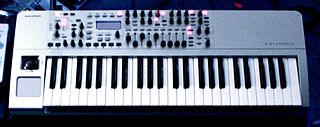 W
WThe Novation X-Station is a virtual analog synthesizer, audio interface and MIDI controller that was released in early 2004, and made by the British company Novation. It is the end-result of adding an audio interface, a KS-class synthesizer and an effects section to the company's ReMOTE controllers. The product was sold for a short time under the name ReMOTE Audio, before being re-branded as the X-Station. Functionally there are no differences between the two, apart from the software, that can be updated through a USB connection, at. It came in three variants : 25, 49 and 61 keys.
 W
WOberheim Matrix synthesizers are a historic product line of subtractive analog synthesizers from Oberheim featuring a system of modulation which Oberheim called "Matrix Modulation" as a method of selecting and routing elements that dynamically shape various aspects of the sounds it produces.
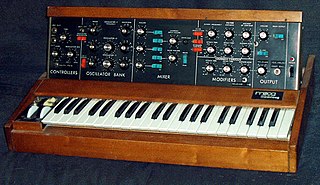 W
WIn electronic music, a pitch wheel, pitch bend or bender is a control on a synthesizer to vary the pitch in a continuously variable manner (portamento).
 W
WThe Radiodrum or radio-baton is a musical instrument played in three-dimensional space using two mallets. It was developed at Bell Labs in the 1980s, originally to be a three-dimensional computer mouse. Currently it is used as a musical instrument similar to a MIDI controller in the sense that it has no inherent sound or effect, but rather produces control signals that can be used to control sound-production As such, it can be thought of as a general telepresence input device. The radiodrum works in a similar way to the theremin, which uses magnetic capacitance to locate the position of the drumsticks. The two mallets act as antennas transmitting on slightly different frequencies and the drum surface acts as a set of antennas. The combination of the antenna signals is used to derive X, Y and Z.
 W
WRoland Juno-G is a music workstation/synth introduced in 2006 by Roland Corporation. It is based on the Fantom-X series, having a vintage design that resembles the first Juno synthesizers, such as the Juno-106. The Juno-G's main competitors in the approximate price range, with similar features, when first released, were the Korg Triton Le/TR and Yamaha MO6 workstation synthesizers.
 W
WThe Roland MC-09 "PhraseLab" is a Roland synthesizer, described as a Roland TB-303 emulator featuring an effects processor and a 4-part phrase sampler.
 W
WThe R-8 Human Rhythm Composer is an electronic drum machine introduced in 1989 by Roland Corporation, using PCM voices. The R-8 features velocity- and pressure-sensitive trigger pads, and the ability to create loops of beats. The device has eight individual outputs, 12-voice polyphony, and four-part multitimbral MIDI.
 W
WThe Roland S-50 is a 61-key 12-bit sampler keyboard produced by the Roland Corporation in 1986. It featured a 3.5-inch DSDD floppy disk drive and had external CRT monitor support to facilitate editing of samples. It could hold up to 32 samples. A rack-mounted version was also available, which featured expanded memory.
 W
WThe SH-3A is a monophonic analog synthesizer that was manufactured by Roland from 1975 to 1981. It is unique in that it is capable of both subtractive synthesis and additive synthesis. Two LFOs and a unique sample-and-hold section provided capabilities not found in competing self-contained synthesizers of the time. The SH-3A was Roland's first non-preset based synth. It was unique for its time in that it offered mixable waveforms at different footages. The predecessor, the Roland SH-1000 could also do this but didn't offer as much control as on the SH-3A. The rhythmic pulsing in the Blondie song "Heart of Glass" is an example of its sound.
 W
WThe Roland SH-1000, introduced in 1973, was the first compact synthesizer produced in Japan, and the first synthesizer produced by Roland. It resembles a home organ more than a commercial synth, with coloured tabs labelled with descriptions of its presets and of the "footage" of the divide-down oscillator system used in its manually editable synthesizer section. It produced electronic sounds that many professional musicians sought after whilst being easier to obtain and transport than its western equivalents.
 W
WThe Roland System 700 was a professional monophonic modular synthesizer for electronic music manufactured by the Roland Corporation and released in 1976 and was followed by the Roland System-100M in 1978.
 W
WThe Roland System-100M was a semi-modular analog synthesizer manufactured by the Roland Corporation in the early 1980s. It was the successor of the Roland System-100, a semi-modular keyboard.
 W
WThe Six-Trak was an analogue synthesizer manufactured by Sequential Circuits in San Jose, California and released in January 1984. It is notable for being one of the first multi-timbral synthesizers, equipped with MIDI and an on-board six-track digital sequencer, hence the name. It was designed as an inexpensive and easily portable 'scratch-pad' machine for trying out arrangements. You can latch the arpeggiator and play along with sequences in real time. Also available is a unison mode which renders the keyboard monophonic but allows for very rich sounding timbres.
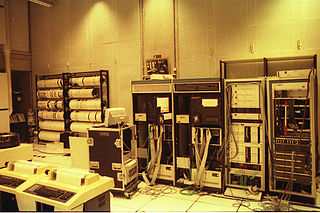 W
WThe Sogitec 4X was a digital sound processing workstation developed by Giuseppe di Giugno at IRCAM (Paris) in the 1980s. It was the last large hardware processor before the development of the ISPW. Later solutions combined control and audio processing in the same computer like Max/MSP. 4X built on the achievements of the earlier Halaphone, capable of timbre alteration and sound localization.
 W
WThe Triadex Muse is a sequencer-based synthesizer, produced in 1972, and designed by Edward Fredkin and Marvin Minsky at MIT. It is an algorithmic, deterministic event generator, utilizing early digital integrated circuits to generate an audio output that can sound very musical. It produces a sequence of notes based on the settings of about a dozen different parameters, including four small sliders that control Volume, Tempo, Pitch, and Fine Pitch. Only a few hundred were ever made.
 W
WThe Waldorf Blofeld is a synthesizer combining virtual analogue synthesis with wavetable synthesis and FM synthesis. It is available as a small desktop unit and as a 49 key velocity and aftertouch sensitive keyboard version. The keyboard version features extra performance controls; these comprise two performance wheels and up/down transpose keys to shift the range of the keyboard. It is named after the character Ernst Stavro Blofeld, the leader of the fictional SPECTRE organisation from Ian Fleming's James Bond series; this lends its name to the sound management computer application SPECTRE, used to send audio and firmware data to the synthesizer. Two subsequent Waldorf synthesizers have been named after Bond villains; the Stromberg and Largo.
 W
WThe Yamaha CS-15 is a Monophonic analog synthesizer produced by Yamaha from 1979 to 1982.
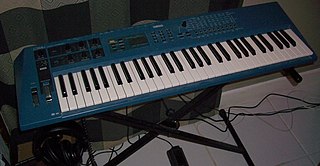 W
WThe Yamaha CS1x is a sample-based synthesizer released by the Yamaha Corporation in 1996.
 W
WThe Yamaha CS2x is a sample-based synthesizer released by the Yamaha Corporation in 1999. The CS2x is designed for maximum real-time control, according to Yamaha. It is the successor of the very successful Yamaha CS1x. Enhancements include 64-note polyphony, a bigger sample ROM and a 24 dB/oct LPF/HPF filter. The CS acronym stands for Control Synthesizer.
 W
WThe Yamaha DGX-620 is the name of a digital piano. The lettering DGX encompasses the word Digital Grand whereas YPG stands for Yamaha Portable Grand, and the only difference between the names are the markets they are sold in. It was released by Yamaha Corporation in late 2006, the first model of the DGX/YPG series with weighted keys.
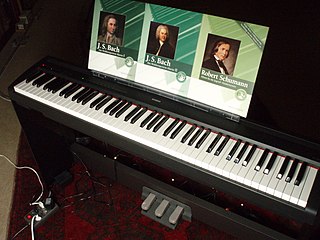 W
WThe Yamaha P-85 is an entry-level digital piano introduced in 2007. It is the successor of the Yamaha P-70 and introduces a MIDI sequencer.
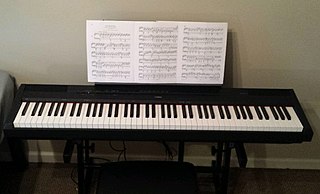 W
WThe Yamaha P-115 is a portable digital piano introduced in 2015. It replaces its best-selling predecessor, the P-105.
 W
WThe Yamaha P-120 is a portable electronic piano, released in 2002. The 88-key so-called "GH" keyboard is action-weighted, imitating the feel of a real piano. It includes several sample keyboard sounds, such as harpsichord, clavichord, vibraphone, guitar and more. Basic sequencing and editing are built-in.
 W
WThe Yamaha PortaSound PC-50 is an entry-level portable musical keyboard produced by the Yamaha Corporation in 1983.
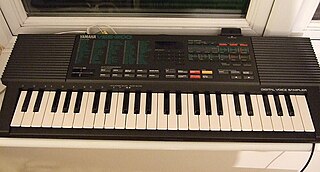 W
WThe Yamaha PortaSound VSS-200 is a portable musical keyboard released by the Yamaha Corporation in 1988.